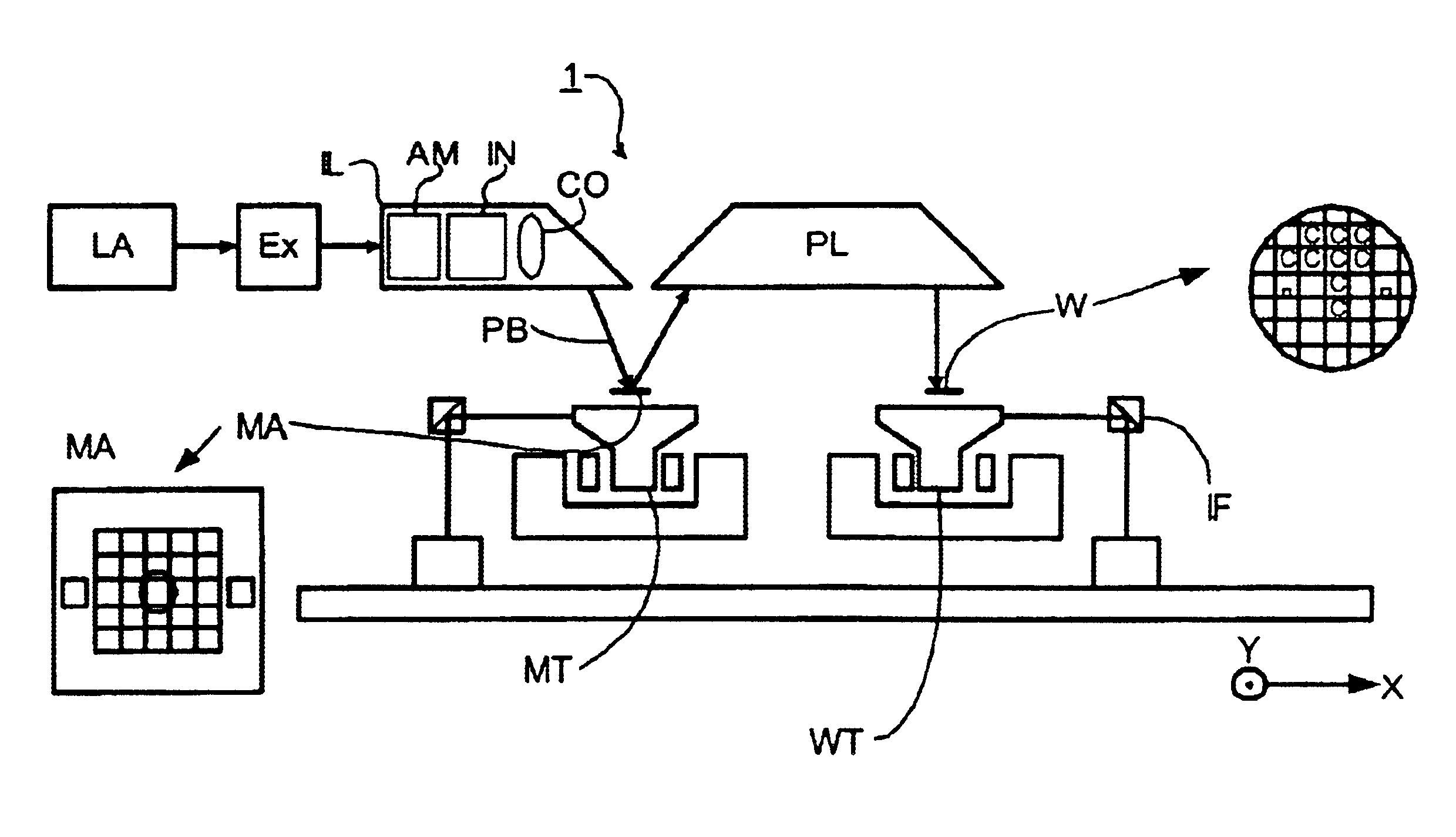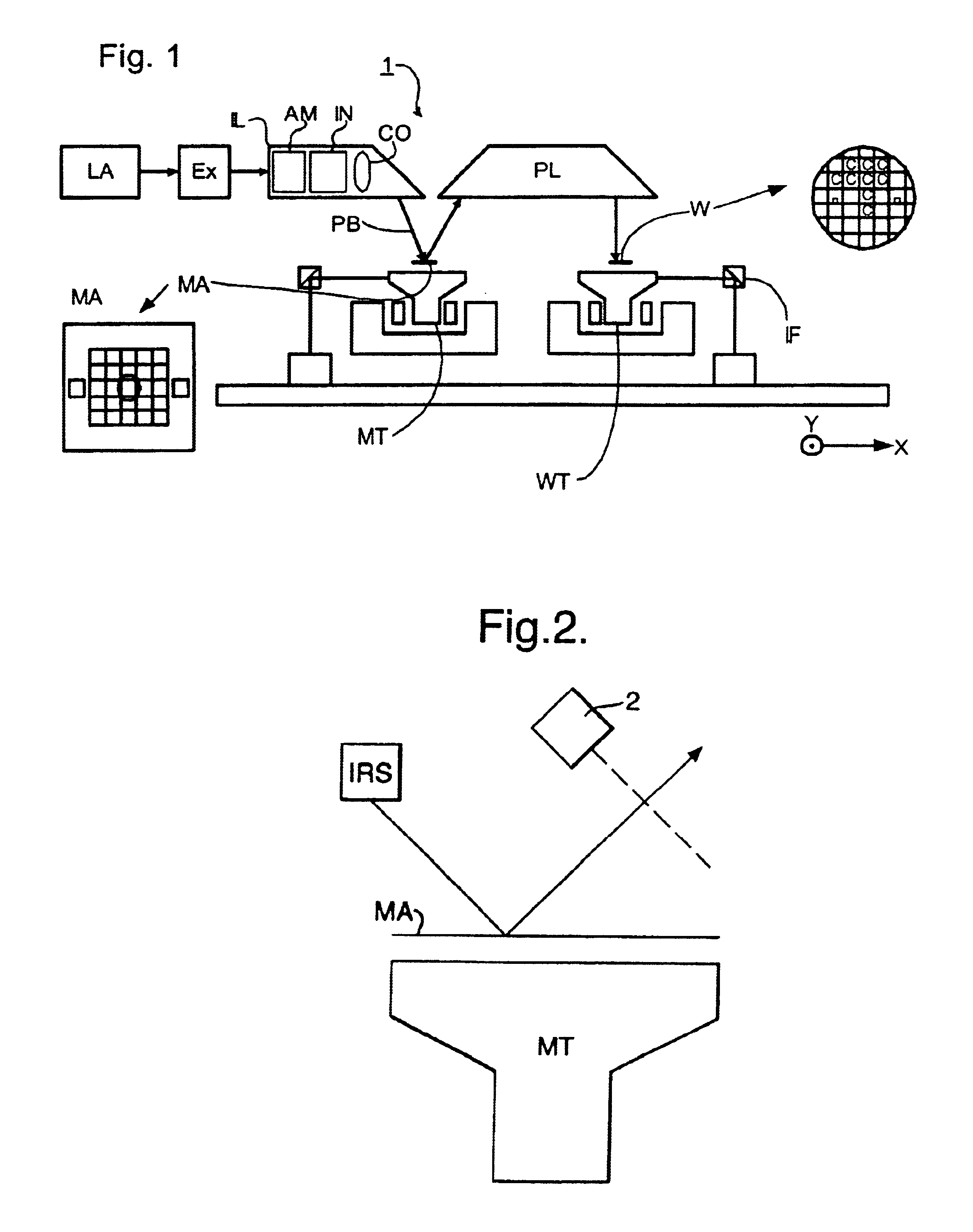Lithographic apparatus, device manufacturing method, and device manufactured thereby
a technology of lithographic apparatus and manufacturing method, which is applied in the direction of x-ray tubes with very high current, radiation therapy, photometry, etc., can solve the problems of unacceptably high significantly more sensitive apparatus operating at such wavelengths to the presence of contaminant particles, and loss of radiation beam transmission. , to achieve the effect of reducing oxidative damag
- Summary
- Abstract
- Description
- Claims
- Application Information
AI Technical Summary
Benefits of technology
Problems solved by technology
Method used
Image
Examples
embodiment 1
[0044]FIG. 1 schematically depicts a lithographic projection apparatus according to a particular embodiment of the invention. The apparatus comprises:[0045]a radiation system Ex, IL, for supplying a projection beam PB of radiation (e.g. UV or EUV radiation). In this particular case, the radiation system also comprises a radiation source LA;[0046]a first object table (mask table) MT provided with a mask holder for holding a mask MA (e.g. a reticle), and connected to first positioning means for accurately positioning the mask with respect to item PL;[0047]a second object table (substrate table) WT provided with a substrate holder for holding a substrate W (e.g. a resist-coated silicon wafer), and connected to second positioning means for accurately positioning the substrate with respect to item PL;[0048]a projection system (“lens”) PL (e.g. a mirror group) for imaging an irradiated portion of the mask MA onto a target portion C (e.g. comprising one or more dies) of the substrate W. As...
embodiment 2
[0066]In a second embodiment of the invention, which is the same as the first embodiment, except as described below, the apparatus is fitted with a sensor 2 to monitor the absorption of the infra-red radiation by the contaminants on the surface of the optical components. As for embodiment 1, infra-red radiation has here been utilised, but it is also envisaged that microwave radiation may be used. In FIG. 2, sensor 2 is depicted as monitoring the absorption of infra-red radiation directed at the mask, but it may also be used to monitor absorption of radiation directed at any optical component.
[0067]As is depicted in FIG. 2, the optical component may be reflective, and the sensor will therefore measure the reflectance of the infra-red radiation. However, if the mask is of a transmissive type, the sensor will be positioned such that it measures the degree of transmission through the mask or other optical component.
[0068]The degree of absorption of the infra-red radiation indicates the ...
embodiment 3
[0071]In a third embodiment of the invention, which is the same as the first embodiment except as described below, the partial pressure of water in the system is reduced by irradiating with infra-red or microwave radiation, preferably infra-red radiation.
[0072]In this embodiment, the radiation system produces radiation in the extreme ultraviolet (EUV) range. For example, the radiation may have a wavelength below about 50 nm, preferably below about 20 nm and most preferably below about 15 nm. An example of a wavelength in the EUV region which is gaining considerable interest in the lithography industry is 13.5 nm, though there are also other promising wavelengths in this region, such as 11 nm, for example.
[0073]In this embodiment the interior of the lithographic apparatus is irradiated with IR light from IR source IRS. The frequency of the radiation is a frequency which is absorbed by water molecules. For example a frequency or a range of frequencies within the range of from 3500 cm−...
PUM
| Property | Measurement | Unit |
|---|---|---|
| wavelengths | aaaaa | aaaaa |
| wavelength | aaaaa | aaaaa |
| wavelength | aaaaa | aaaaa |
Abstract
Description
Claims
Application Information
 Login to View More
Login to View More - R&D
- Intellectual Property
- Life Sciences
- Materials
- Tech Scout
- Unparalleled Data Quality
- Higher Quality Content
- 60% Fewer Hallucinations
Browse by: Latest US Patents, China's latest patents, Technical Efficacy Thesaurus, Application Domain, Technology Topic, Popular Technical Reports.
© 2025 PatSnap. All rights reserved.Legal|Privacy policy|Modern Slavery Act Transparency Statement|Sitemap|About US| Contact US: help@patsnap.com


